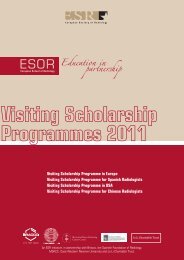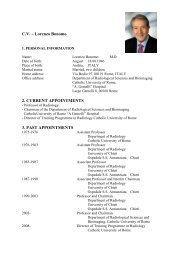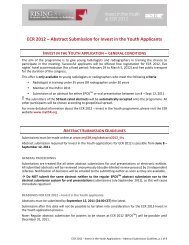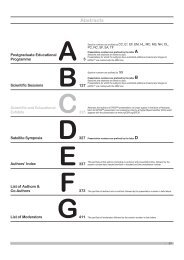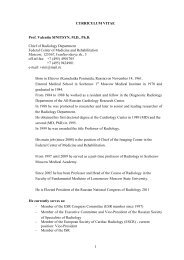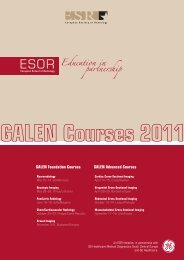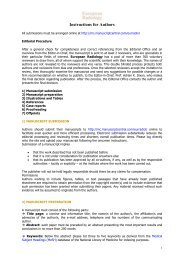Postgraduate Educational Programme - myESR.org
Postgraduate Educational Programme - myESR.org
Postgraduate Educational Programme - myESR.org
- No tags were found...
You also want an ePaper? Increase the reach of your titles
YUMPU automatically turns print PDFs into web optimized ePapers that Google loves.
<strong>Postgraduate</strong> <strong>Educational</strong> <strong>Programme</strong>and both middle and inner ear) and of otosclerosis (a particular emphasis is puton the footplate which requires an excellent technic). MR opens a new way in thediagnostic of Meniere disease (the dilation of the saccule is nicely demonstratedwith a 3 T MR unit) and in the analysis of the membranous labyrinth particularly inlabyrinthitis. A new way of reading the inner ear is also provided by the 3 T machines.The foundation of the performance in imaging remains the knowledge of anatomy.Learning Objectives:1. To understand the normal imaging anatomy.2. To learn about the role of CT and MRI in the evaluation of congenital malformations.3. To become familiar with the most common acquired lesions of the middle andinner ear.A-074 09:30C. Sella and parasellar pathologyR. Gasparotti; Brescia/IT (gasparo@med.unibs.it)The sellar region can be subdivided into three anatomical compartments, intrasellar,suprasellar and parasellar, each of which is characterised by different diseases.Although pituitary adenomas represent 90% of all sellar masses, a large spectrumof diseases can be encountered in such a small area, including congenital lesions,tumours, infectious and inflammatory conditions and vascular pathologies. The aimof neuroimaging is to characterise and to precisely define the anatomical relationshipsof the lesions, since a thorough understanding of the radiological anatomyis essential for the differential diagnosis and treatment planning. MRI has almostcompletely replaced CT in the study of the central skull base, because of its superiorcapability of tissue characterisation, although some tumours arising in this areamay still take advantage from CT, which better identifies the extensive calcifiedcomponents typical of craniopharingiomas or giant partially thrombosed aneurysms.A reliable diagnosis of sellar or parasellar mass lesion can usually be obtainedwith conventional MRI based on T2W and pre/post-gadolinium T1W sequences,however, advanced MR techniques may be relevant for further characterisingthe lesions. DWI sequences may represent a useful adjunct for the preoperativeassessment of macroadenomas; 3D SPACE sequences may be used to identifyeither microcystic or tiny solid components respectively into large solid or cysticlesions, whereas 3D T1W fatsat post-gadolinium sequences can better displaydural enhancement and cavernous sinus invasion by intrasellar mass lesions. Wepresent an overview of the relevant neuroimaging features of sellar and parasellarpathology, including the differential diagnoses with less common lesions.Learning Objectives:1. To consolidate knowledge about the normal anatomy and the age relatedpatterns of the normal pituitary gland.2. To learn how to evaluate congenital and acquired lesions of the sella andparasellar region.3. To become familiar with imaging protocols.08:30 - 10:00 Room F1Multidisciplinary Session: Managing Patients with CancerMS 4Hepatocellular carcinomaA-075 08:30Chairman’s introductionB. Sangro; Pamplona/ES (bsangro@unav.es)A variety of options are available for the treatment of hepatocellular carcinoma (HCC)from liver transplantation or resection to percutaneous ablation by chemical or physicalprocedures, intraarterial injection of embolizing particles that may also serveas carriers of chemotherapeutic agents or radiation-emitting isotopes, or systemicdelivery of molecularly targeted agents. Although large scale studies have identifiedgroups of patients that may certainly benefit from some of these therapeutic tools,many areas of uncertainty still exist. Only by the coordinated action of HPB Oncologymultidisciplinary teams may patients with HCC receive the best possible treatment.Session Objectives:1. To learn the current management of HCC as laid out in scientific guidelines.2. To identify those areas of uncertainty, where multidisciplinary teams are neededmost.3. To understand the basis of personalised care for HCC patients and the needfor multidisciplinary teams.Author Disclosure:B. Sangro: Advisory Board; Bayer Healthcare and Sirtex Medical. Speaker;Bayer Healthcare and Sirtex Medical.A-076 08:35Abdominal radiologyA. Benito; Pamplona/ES (albenitob@unav.es)Worldwide accepted staging procedures for hepatocellular carcinoma include dynamicCT or MRI, both based on typical tumoural behaviour after contrast in arterial(hypervascular) and in portal-venous phases (“washout” appearance). However,some tumours may show ambiguous features that precludes staging. Recentadvances such as perfusion for CT or diffusion and liver-specific contrast agentsfor MRI have demonstrated a potential role to solve disagreements in diagnosis,staging, or distinguishing the grade of malignancy. Imaging tumoural responseafter non-surgical treatments (ablation, chemoembolisation, radioembolisation orsorafenib), based on tumoural viability as estimated by the degree of hypervascularizationin the arterial phase (modified-RECIST) seems to be more appropriatethan conventional systems (WHO/RECIST). However, uncommon radiologicalpatterns can be seen after sorafenib (gradual decrease in tumour hypervascularitybefore shrinkage) or after radioembolisation (heterogenous patchy hypervascularareas and/or fibrosis) leading to misinterpretation or late recognised responses ifonly morphologic changes are considered. Ethanol injection and RFA have beenthe two most employed local ablative techniques for the local control of HCC.However, other procedures could offer potential benefits. The use of microwaveablation is growing recently due to some presumed advantages such as largerablations, shorter duration, less susceptibility to heat sink effect, or no requirementof grounding pads. Irrevesible electroporation is also a new non-chemical, nonthermaltechnique (still under clinical investigation) that is based in the applicationof multiple direct pulses that result in an irreversible disruption of the cell membraneleading to cellular death.Learning Objectives:1. To learn which imaging procedures should be considered standard of care forstaging HCC and which are potential improvements that await confirmation.2. To understand the limitations of imaging in the diagnosis and evaluation ofresponse to locoregional and antiangiogenic therapies.3. To learn about the scientific evidence supporting the use of percutaneousablation procedures other than radiofrequency.A-077 08:50Interventional radiologyJ.I. Bilbao; Pamplona/ES (jibilbao@unav.es)The rationale to perform endovascular procedures for the treatment of patientswith Hepatocellular Carcinoma (HCC) is based on the anatomical fact that liverneovascular networks are nourished exclusively by arteries. Thus, HCC may beselectively treated by delivering therapeutic agents through the afferent arteries.Ischaemia, provoked by the selective endovascular deployment of particles, mayinduce tumoural necrosis with high local control. The drawback is that ischaemiawill also actively induce neoangiogenesis which may facilitate tumoural recurrence.Targeting of tumoural vessels is higher if smaller particles (or fluids like Lipiodol)are used and, for this reason, they could be loaded with anticancer agents. Ithas been widely reported the high local control rates obtained with the mixedeffect given by ischaemia (macroembolisation) and the delivery of drugs (chemoembolisation,drug-eluted-embolisation). Since macroembolisation will provokeischaemia in the embolized volume the procedure must be performed, as selectiveas possible trying to avoid any damage to the surrounding, usually cirrhotic, liverparenchyma. If not achievable the treatment should not be performed in patientswith liver insufficiency or in the presence of thrombosis of the main portal branches.Endovascular treatments may, even, pursue the superselective deployment of ananticancer agent (drug, radionucleide, antibodies) avoiding any ischaemic effect(microembolisation). Taking into account these considerations, their indicationsare increasing in patients with HCC. Several reports demonstrated its usefulnessas a palliative method improving both local control and patients´ survival. But alsotumours can be downstaged and then patients can receive curative treatments(surgery or ablation).Learning Objectives:1. To learn about locoregional intraarterial therapies currently being used forHCC and the rationale behind their use.2. To become familiar with patient selection for embolising procedures prior toand after angiographic evaluation.3. To learn some tips that may help reduce side effects and prevent complicationsof transarterial therapies.S24AB C D E F G



